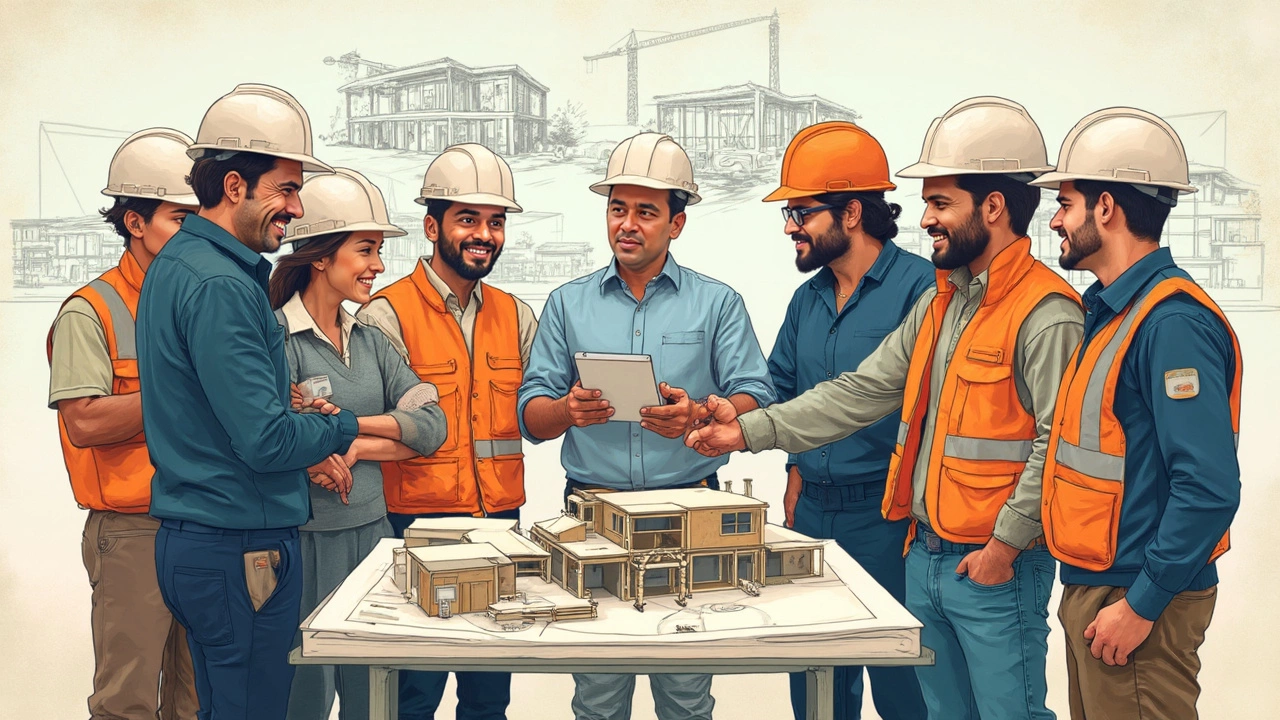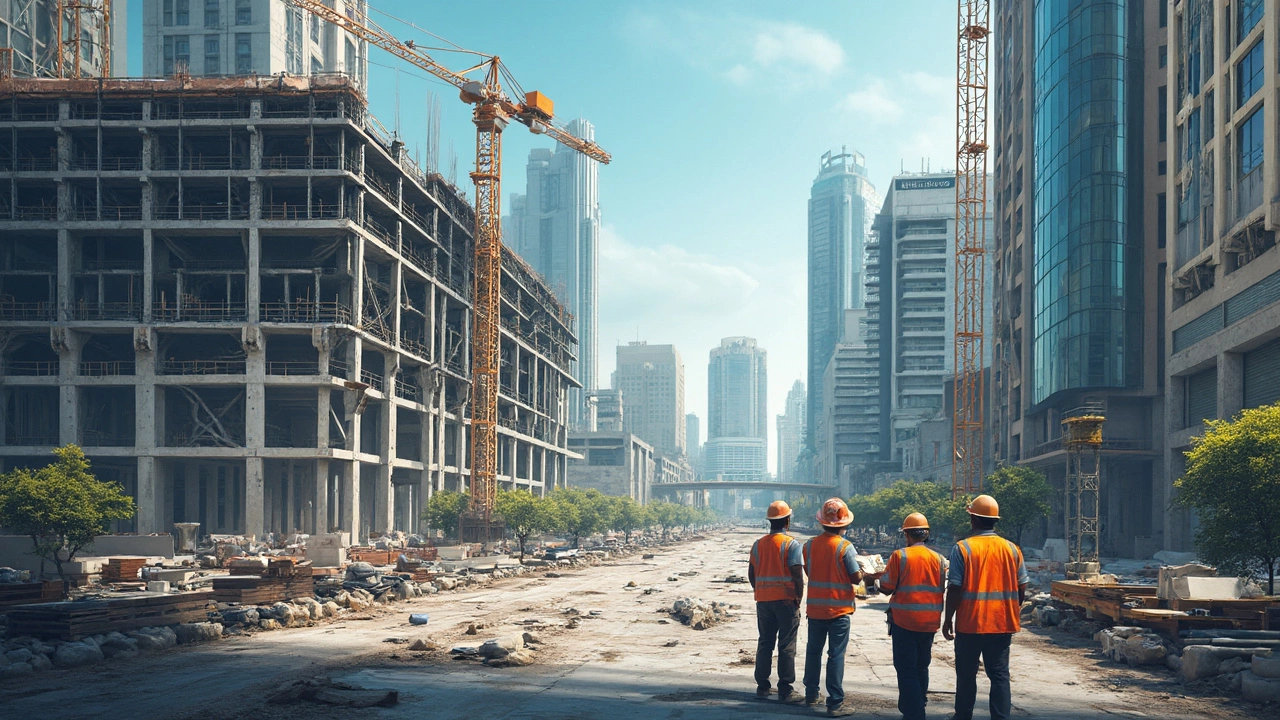You probably walk past office buildings, warehouses, or big-box stores daily without giving their bones a second thought. Truth is, there’s no single right way to put up these structures—they all start with a big choice: which construction method to use? This decision shapes not just how things look, but the speed, cost, and energy the whole project takes. Stuff like steel beams, thick concrete panels, or even modular boxes all come into play.
If you run a business or manage projects, it’s smart to get a handle on these methods—otherwise, you’re playing a game without knowing the rules. Want to avoid cash-sucking delays? Or make sure your new building can flex for the future? Knowing which method fits best sets you up for fewer surprises down the road.
- Steel Frame Construction
- Concrete Methods: Tilt-Up and Precast
- Wood Framing for Commercial Buildings
- Modular and Prefabricated Construction
- Key Tips for Choosing the Right Method
Steel Frame Construction
Steel frame construction is the backbone of most modern commercial buildings. You’ll spot these steel skeletons rising fast in city centers, on school campuses, or shaping massive warehouses. The basic idea is simple: strong vertical columns and horizontal beams connected together. But there’s a lot going on under the hood that makes this method a go-to for developers and architects.
The big draw? Strength and flexibility. Steel handles heavy loads and crazy wind better than just about anything else. It also lets designers get creative with open floor plans—there aren’t chunky walls or endless pillars blocking the way. For high rises (think anything over four stories), steel is usually non-negotiable.
- Super fast to put up—pieces are prefabricated off-site and just bolted or welded together on arrival.
- Fire resistance is another win. Ever see a steel skeleton standing after a fire? That’s not by accident.
- Great for wide open spaces like gyms, car showrooms, or conference halls—no need for columns everywhere.
But it’s not always perfect. Without regular inspections, steel can rust. Insulating a steel building takes more work than you’d think too. Still, most big-name commercial buildings lean on steel frames because they’re strong, light, and surprisingly easy to modify later if a business wants to expand or reconfigure.
Here’s a quick look at some numbers:
| Characteristic | Steel Frame Construction |
|---|---|
| Speed of Assembly | 1-2 weeks per floor for most multi-story builds |
| Average Lifespan | 50+ years with regular maintenance |
| Recyclability | Over 90% of steel can be recycled |
| Common Projects | Offices, hotels, warehouses, hospitals |
If you want a building that goes up fast, lasts decades, and can stand up to hard use, commercial construction with steel framing is a no-brainer for new commercial projects. It’s everywhere for a reason: quick, reliable, and strong as it gets.
Concrete Methods: Tilt-Up and Precast
When it comes to big commercial buildings—warehouses, schools, even grocery stores—concrete is king. But how the concrete goes up makes a huge difference. The two heavy hitters you’ll hear about are tilt-up and precast. Both get you strong, reliable walls, but they take different routes to get there.
Tilt-up construction is kind of wild to watch. Workers pour slabs of concrete flat on the ground, right at the job site. Once they cure, a crane tilts them up into place like giant dominoes. These panels can be massive—sometimes more than 60 feet long and weighing over 100,000 pounds. The trick? You need enough space on-site to lay out those panels before they get lifted. It's quick (often shaving weeks off the calendar compared to building walls the old way), and it's usually cheaper for larger square-footage projects.
On the other hand, precast concrete means the walls are made in a factory, usually miles away. Each panel or section is crafted in controlled conditions, which makes for really consistent quality. These panels show up ready to go, kind of like giant puzzle pieces. Crews just swing them off trucks and attach them to the frame, speeding things up and keeping your schedule tight. Precast is awesome for jobs where site space is tight or you need special finishes (think: polished, colored, or textured looks).
Check out how the two methods stack up:
| Method | Where Built | Typical Use | Speed | Cost Range | Site Space Needed |
|---|---|---|---|---|---|
| Tilt-Up | On-site | Warehouses, Retail, Schools | Faster for large footprints | $35–$55/sq ft | Lots of open space |
| Precast | Factory | Offices, Parking Garages, Tight Sites | Fast install, less weather delay | $45–$65/sq ft | Minimal |
If you’ve got a big plot and need to move fast, tilt-up is hard to beat. But if you’re in a cramped city lot, or you care about fancy finishes and perfect surfaces, precast might be worth the extra bucks. Worth remembering: both methods are getting more popular for their speed and durability, especially as labor costs keep climbing. Whether you’re going for budget or premium, concrete’s versatility is tough to match.
One last tip: pay attention to your local weather and access to skilled crews. Poor planning here eats up your savings fast—no matter which method you pick.

Wood Framing for Commercial Buildings
Most folks think wood framing is just for homes, but you’d be surprised how many commercial buildings are built with wood—especially small offices, restaurants, or low-rise multi-family buildings up to four stories. Why? It’s often the budget-friendly pick and super fast to put together. Plus, wood is easy to modify if you ever need to remodel or expand.
Biggest win: materials show up ready to go and local construction crews know how to handle them. That means you save time and cash right from the start. Just keep in mind—wood isn’t the best for every job. Code limits usually keep wood-framed commercial buildings below five stories, mainly because fire rules get much stricter as you go higher. In some cities, fire retrofitting on older wood frame buildings can cost a pretty penny.
For certain situations, though, wood framing stands out:
- Budget is tight and you want lower labor costs.
- You need to build quickly—think coffee shop chains or medical offices.
- Local codes don’t require concrete or steel due to height or fire regulations.
Folks sometimes ask about energy efficiency. Modern wood framing, when paired with proper insulation, actually holds its own against steel and concrete in terms of heating and cooling costs. According to the U.S. Forest Service, wood-framed buildings can use up to 30% less embodied energy compared to concrete or steel ones. That means construction itself leaves a lower carbon footprint, which helps if your project needs to check green boxes.
| Pros | Cons |
|---|---|
| Lower cost | Height and fire limits |
| Quicker build times | May need more maintenance |
| Easy to remodel | Susceptible to pests and rot if not protected |
Here’s a tip for business owners: If you’re crunching numbers, check if local suppliers can source lumber on a tight deadline. Supply chain hiccups made headlines during the 2020s, so you’ll want rock-solid confirmation before you start digging. And always, always make sure your insurance is up to code since rates can jump higher for wood-framed commercial buildings, especially in fire-prone areas.
In short, commercial construction with wood framing isn’t just for old strip malls. If your project fits the profile, you might end up saving money, wrapping up faster, and keeping future changes simpler. Just be ready to jump through a few code hoops and plan for the extra steps if your city puts up fire safety roadblocks.
Modular and Prefabricated Construction
Think construction has to be slow and messy? Not with modular and prefabricated construction. This method takes whole chunks of a building—like walls, bathrooms, or even entire rooms—and builds them in a factory. These big sections show up at the site on a flatbed truck, ready to snap together like Legos. That’s a game-changer for tight schedules or sites that can’t deal with constant noise and traffic.
The buzz here is all about speed and less headache on-site. Stats from the Modular Building Institute say modular construction can cut build times by up to 50%. And it’s not just about speed—fewer workers on-site means less risk and less waste.
| Benefit | How it Helps |
|---|---|
| Faster Build | Up to 50% quicker than old-school methods |
| Less On-Site Disruption | Fewer trucks, less noise and traffic jams |
| Weather Problems? No Problem | Most work happens indoors |
| Quality Control | Factory setting means tighter checks |
You see this method in hotels, schools, medical clinics, and fast-food joints that just can’t wait a year to open. Burger chains have even turned whole restaurant builds into “drop and go” projects, opening weeks ahead of schedule. Pretty wild when you think about how long traditional builds drag on.
- Good for repeating layouts—think offices with the same floor plan on every level or apartments stacked up identical.
- Watch out if you need custom design—modular shines when things are standard, but it’s less flexible for unique shapes or fancy finishes.
- Careful planning is key. You can’t order a missing wall at the last second—if it doesn’t fit, the factory needs to fix it before shipping.
The commercial construction industry uses modular more and more, mostly because owners hate project overruns. The upfront work is intense: everything down to the plumbing and wiring needs nailing in the plans first. But once the modules show up, buildings really do pop up fast. Even hospitals, which have crazy strict rules, are using modular to get open faster—and with fewer delays caused by weather or labor hiccups.

Key Tips for Choosing the Right Method
Missing the mark on which commercial construction method fits your project can cost you big—both in dollars and headaches. There’s no shortcut to success, but a few tried-and-true steps will help you make a solid choice.
First off, look at your budget and your schedule together. Here’s the deal: Steel framing usually costs more up front than wood, but it can save weeks when you’re dealing with bigger buildings. If you’re pressed for time, modular and prefab options cut construction by up to 50% compared to traditional methods. That’s no joke—it’s straight from a 2022 report by the Modular Building Institute.
Another big factor? Your site’s location and layout. If you’re building in a city center with tight streets, tilt-up concrete might be out because it needs lots of space to lay those big panels flat before they’re lifted up. Cold-weather zones? Wood can struggle unless you go high-end, but steel and concrete handle the freeze well.
Don’t forget about future modifications. Steel frames make it easier to rework floor plans later without tearing out half the building. For businesses that expect to grow or shuffle tenants often, that kind of flexibility is gold.
- Commercial construction in the U.S. skews 60% steel, with concrete taking close second for warehouses and retail.
- Modular projects now make up about 6% of new builds—fastest growth in healthcare and schools.
- Precast panels can lower long-term maintenance by up to 20% for properties in rough weather regions.
Here’s a quick side-by-side to help compare:
| Method | Speed (weeks for 50,000 sq ft) | Avg Cost/sq ft | Flexibility |
|---|---|---|---|
| Steel Frame | 24 | $40-70 | High |
| Tilt-Up Concrete | 20 | $35-60 | Medium |
| Wood Framing | 26 | $30-50 | Low |
| Modular/Prefab | 12 | $45-80 | Medium |
Always bring in your architect and builder early. No method is a “one-size-fits-all,” so getting expert advice before locking in your strategy pays for itself. Ask tough questions: Can you shrink timelines with prefab? Will steel raise insurance costs? Will concrete hold up if you plan to expand in five years? Smart owners know it’s not just about building fast—it’s about building for what’s next.
